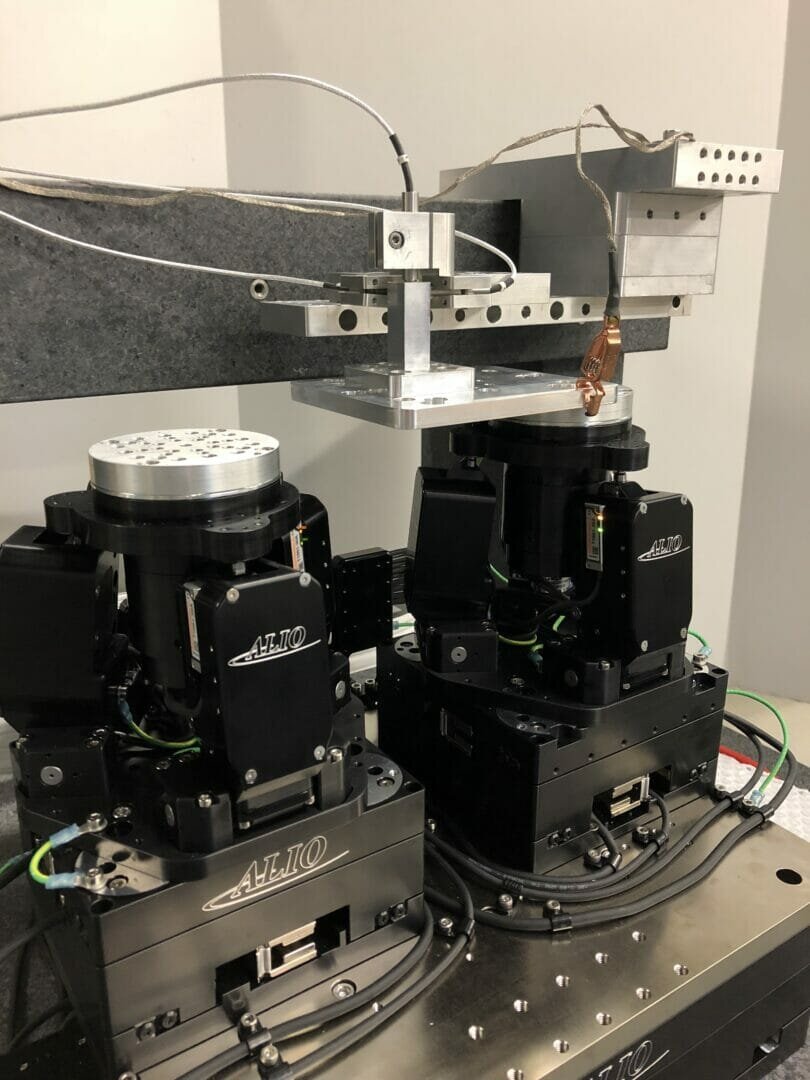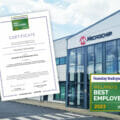ALIO Industries, an Allied Motion company, is a leader in producing high-precision motion control systems with ultra-precise point and path positioning performance that is NIST-traceable. The company’s off-the-shelf and customized motion control solutions are the most precise and repeatable in the world, all backed by the industry’s first 3-year warranty. In this article Bill Hennessey, Founder and President of ALIO Industries gives his views on the ever changing and evolving demand for more and more precise motion control solutions, and discusses his and ALIO’s approach to the creation of technology that stimulates innovation across industry.

Q. Can you provide an overview of ALIO and its core focus as an ultra-precise motion control specialist technology supplier?
BH. From day one ALIO’s focus was to push the nanometer envelop using novel ideas from machining to assembly. Personally, I thought nanometer-level motion control was needed as far back as the JDS Uniphase Corporation (JDSU) days in the 1990s when they were designing and manufacturing a variety of products for optical communications networks. The Dense wavelength-division multiplexing (DWDM) optical transmission technology that took over from the JDSU technologies in the 2000s definitely needed nanometer-level motion control. For industries such as this where precision was so vital, quality was also a must as were motion control solutions that were robust industrial products not just devices to be used in a lab. I used my machine tool and industrial robots background to build quality, precise motion control systems that were fit for high volume manufacturing scenarios. At the same time as we applied for the patent for our novel Piezo Hybrid Hexapod, along came Dense Wavelength-Division Multiplexing (DWDM) optical transmission technology, and this industry suddenly did not need as many devices since a fiber could now carry many different channels.
Q. What factors do you believe have contributed to ALIO’s success in the motion control industry?
BH. We stayed the course and never sacrificed our integrity, focus, or reputation for quality by compromising the exacting precision levels that we pioneered. We have lost many orders over the years by telling customers the truth about what they could expect in terms of precision. Customers ending up with inappropriate or sub-optimal motion control solutions does nothing for the reputation of the entire motion control sector, and with this in mind we continue to put honesty in customer dialogue beyond anything else. From this, creating and providing pragmatic solutions that meet customer expectations can follow.
Q. Could you share some examples of how ALIO’s motion control solutions have delivered significant benefits to customers compared to traditional alternatives?
BH. We provide game changing products that are disruptive due their precision and quality across an array of industries and applications. Unfortunately, due to the strategic nature of the motion control solutions that we provide, we are usually unable to give specific details. However, I can tell you that we have customers that not only restrict us from mentioning them, but who ask (or even offer to pay a premium) for us not to place our name on the motion control systems we have supplied them so they can protect their technological advantage.
Q. What are the key application areas that ALIO is currently focused on in terms of providing ultra-precise motion control solutions?
BH. Metrology has always been an ALIO specialty, with the world’s top metrology companies using out products as their internal reference systems, and some as their OEM system. Ultra-fast laser processing, digital pathology, genome sequencing and a lot of semiconductor processing applications represent our key markets today.
Q. Are there any particular industries or sectors where ALIO’s technology has found the most success and impact?
BH. There are many, but in the area of Digital Pathology we perhaps exhibit our prowess most obviously. To ensure accurate and complete tissue sample analysis, high bi-directional repeatability to target small tissue areas is needed in digital pathology applications. ALIO provides monolithic, low-profile, open-center X, Y, Z electromagnetic driven stages for such applications, promoting high speed, high throughput, and low friction in a small footprint, scan times being reduced allowing better pre-scan images. Digital pathology is all about parallel paths or a serpentine motion to capture all the data points. ALIO is novel in that our straightness is superior to all other motion control options for this application. This promotes the compiling of data in one pass impossible if stages cannot move parallel with less than 2-3 micron variation. This also make for more precise data since it does not need to be calculated by 6 sigma algorithms that are necessary to get a result from poor motion performance.
We also excel in areas like 4K and 8K lens assembly, measuring optics for satellites, laser cutting of gems or sapphire, and genome sequencing all of which require exacting precision and / or the requirement to capture data at record speeds.
Q. How does ALIO stay ahead of emerging trends and technology advancements in the field of ultra-precise motion control?
BH. ALIO began focusing on nanometer-level motion control some 21 years ago, so we never stop thinking of the next generation trends and technologies. At this time, I would say that we are a decade in front of the competition. Without giving away too much, we are always looking at ways to measure and assemble new kinematic motion control solutions with novel materials, and this is an area of particular focus at the moment.
Novel materials can exhibit unique properties such as high stiffness, low thermal expansion, and exceptional dimensional stability, allowing for enhanced precision and accuracy in motion control applications. By incorporating these materials into the design of such systems, it becomes possible to minimize unwanted vibrations, reduce friction, and mitigate the effects of thermal fluctuations, thereby improving overall system performance. Furthermore, the introduction of novel materials can enable the development of miniaturized, lightweight systems with improved reliability, responsiveness, and energy efficiency, opening up new possibilities for advanced motion control in fields such as robotics, microscopy, and precision manufacturing.
Q. What is the company’s strategy for staying innovative and continuously improving its motion control solutions?
BH. Continuous improvement for us at ALIO is like breathing. We are always seeking to improve, and we always ensure we have a team of engineers at the top of their game.
Specifically, we promote continuous improvement by fostering a culture of innovation, collaboration, and feedback. We invest in research and development to explore emerging technologies, novel materials, and advanced algorithms that can enhance the precision, accuracy, and performance of our motion control systems. We actively engage with customers and industry experts to gather feedback and insights, allowing us to identify areas for improvement and address specific customer needs. This feedback-driven approach enables us to iterate on our designs, incorporate user-centric features, and refine our manufacturing processes. Additionally, we prioritize ongoing training and development for members of our team, ensuring they stay updated with the latest advancements and can contribute to the continuous improvement efforts.
By embracing this holistic approach, as an ultra-precise motion control solution provider we can remain at the forefront of innovation, consistently delivering state-of-the-art solutions that exceed customer expectations.
Q. Can you provide insights into any ongoing research and development efforts at ALIO aimed at advancing ultra-precise motion control?
BH. The challenge for ALIO is trying as far as possible to mitigate the costs of materials and software etc… that allows our nanometer-level precision motion control systems to operate in scenarios where environmental conditions in industrial settings are not ideal.
Building ultra-precise motion control systems operating in environmental conditions that include thermal deviations and vibrations poses significant challenges. The presence of thermal fluctuations introduces unpredictable dimensional changes in the system, requiring careful thermal management strategies to minimize their impact on positioning accuracy. Vibrations, whether originating from internal or external sources, can disrupt the delicate motion control mechanisms and degrade overall performance.
Addressing these challenges requires a combination of meticulous mechanical design, sophisticated control algorithms, and the use of specialized materials with low thermal expansion and high stiffness to minimize the effects of thermal deviations and vibrations. Additionally, advanced sensing and feedback systems, such as precision accelerometers and encoders, are necessary to continuously monitor and compensate for any disturbances, enabling the system to maintain the desired nanometer-level precision even in challenging environmental conditions.
Q. What steps does ALIO take to ensure that its customers achieve optimal results and maximize the performance of the motion control systems they purchase?
BH. Every machined part and indeed every assembly gets tested and approved before it leaves our facility. Most suppliers test stages not motion systems. But how can a customer be confident in a motion system that hasn’t been tested as solution. It is effectively nothing other than several individually tested stages stacked together, hoping the performance of individual stages have not been compromised in the process. By testing every motion systems before delivery we ensure it works perfectly on day one at the customer’s facility.
We also have a metrology lab that has few equals, and we have developed over the years our Point Precision® approach to motion metrology that has recently been adopted into ASME B5.64 standard for motion metrology.
All motion systems operate in 3-dimensional space and have errors in 6 degrees of freedom (6-DOF). However, motion systems are often only characterized by performance data of a single or subset of these 6-DOF. This practice leaves several error sources unaccounted for in performance data and specifications. ALIO has contended for over 20 years that repeatability performance for metrology inspection and manufacturing systems must be analyzed and specified using a “point repeatability” method that accounts for 6D spatial errors in order to provide true representation of nanometer-precision performance. The ASME B5.64 standard for motion metrology shows that today standards organisations also see its importance.
Q. What do you believe sets ALIO apart from other motion control technology suppliers in terms of its approach, expertise, or customer-centricity?
BH. Well, quite simply we have been doing this for 21 years, and the mission has always been the same, nanometer-level precision and quality . We always think out of the box, which is reflected in the definition of ALIO…. a new and better way!
We have never built a product without a customer application in mind. Where most build standard products, we have developed our portfolio of motion control solutions based on real world applications.
Q. In your opinion, what are the key qualities or factors that customers should consider when selecting a motion control solutions provider, and how does ALIO excel in those areas?
BH. Never take spec sheets from our competition at face value. Many quote “best-case” precision data, not the precision that can be met day in and day out repeatably.
Also, ask about warranty. If it is one year, then run for the hills. Customer application development can take years, so they need support for a long time to get over the learning curve.
In addition, ask your shortlisted supplier if they can prove they have what it takes to meet or exceed your requirements. Point Precision® in the ASME B5.64 standard is one way to make sure the product meets your need for the application. A reliance on old school planar data can be misleading, and in worst case scenarios can kill off projects due to under-performance.
Finally, look for evidence of a state-of-the-art metrology lab, and also a cleanroom for next-level assembly required by and increasing number of applications across industry.
If all of the above can be answered and demonstrated positively then you can only be at our facilities in Arvada. We look forward to working with you!!







